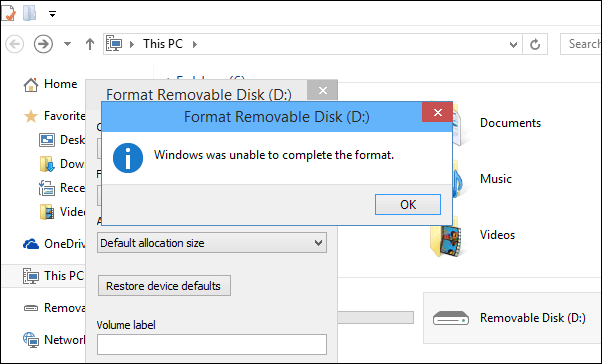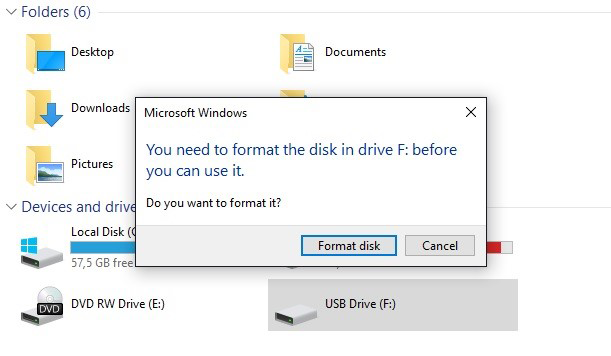Table of Contents
PC running slow?
Over the past few days, some drives have encountered a known bug with USB NTFS Format Error. This problem can occur due to many factors. Let’s discuss this now. NTFS (New Technology File System) is a new type of disk. Microsoft introduced NTFS in 1993 as an enterprise-class component of Windows NT 3.1 and then Windows in 2000, although it did not become popular on consumer PCs until 2001 with Windows XP. Windows 7 and 8 assume NTFS format on new computers.
We have previously shown you how to format a USB drive in Windows 10. The process is actually quite simple and shouldn’t take more than a minute.
After formatting, youshould receive the following message:
But even then, Windows files may not format your USB drive.
For example, when you plug a drive into a laptop port, right-click the world-famous hard drive and choose Format, but an error pops up:
“Windows was unable to perform native formatting”
So what’s the deal? Does this mean that the flash drive is defective? Not really!
PC running slow?
ASR Pro is the ultimate solution for your PC repair needs! Not only does it swiftly and safely diagnose and repair various Windows issues, but it also increases system performance, optimizes memory, improves security and fine tunes your PC for maximum reliability. So why wait? Get started today!

In this factual article, we’ll show you how to fix this weird error Windows can’t format USB drive.

All you have to do is follow the step by step instructions below.
Typical Errors When Windows Cannot Format A USB Drive
Depending on the operating system (Windows 10, 8, 7, Vista, XP) you are using, the error campaigns may vary on a case-by-case basis. Here are the most common:
How do I fix a USB drive that won’t format?
Make sure the USB drive is not write protected.Scan your computer and USB drive for viruses.Run CHKDSK analysis on a USB stick.Format your USB stick using the command line.
The possible causes of all these formatting errors are also different. For example, a flash drive is undoubtedly damaged due to improper ejection or an unexpected shutdown of the PC. There may also be compatibility issues between the player and the PC.
Can a USB be formatted to NTFS?
Right-click USB Drive or External Storage Device. Select Format from the context menu. From the File Process drop-down menu, select NTFS. Select “Start” to start formatting.
Another common good reason is the file error system. For example, a new flash drive almost always starts via FAT-32.

You (or the man or woman using it) may have reformatted this method to NTFS or another file system.
Why Is The File System Important? Maybe
You are surprised. We would be like the usage analogy the reader has already made of us.
A USB flash drive is almost like a book, the data is the terminology of the book, the format is considered It feels like paper that words are written on – different book publishers are using exciting new types of paper.
Now you understand. Back to topic.
Before Formatting The USB Drive
Can a USB be formatted to NTFS?
Right click on the USB stick or external storage device. Select Format from the context menu. From the File System drop-down menu oncall NTFS. Select Start to start formatting.
Make sure you have already created a deep backup of the data stored on your drive. If you haven’t, and each of our files stored there is important to individual people, try USB data recovery software to see if it helps. Just tell your PC USB drive, maybe have a recovery program scan your USB drive for recoverable items.
Even if you have access to several other computers, try successfully connecting the USB drive and then check if the drive is accessible or formatted. Sometimes this helps with clear compatibility or perhaps buffering issues. If this does not help, follow the instructions below.
How To Solve The Problem When Windows Cannot Complete The Format
To put it simply, you need to go into disk management and reformat your drive. k. Here’s how to get there:
- Insert the USB stick into your computer.
- Move the cursor to the upper left corner. Right-click the Windows icon.
- Select Disk Management.
- Highlight the drive representing your flash generator, right-click and select “Create Simple Volume”.
- Now choose your formatting options, under “File system” select FAT-32 or exFAT.
- Click “Next” to complete the restore process.
If that doesn’t work, use a command expression to initialize the player. Video offers more:
How To Format A USB Drive If Windows Says The Drive Is Write-protected
Note. Our PC is running Windows 10. Therefore, all of the screenshots below were taken with Windows 10. If you’re using Windows 8.1, 6, Vista, or XP, things are a little different.
Why should I format my USB to NTFS?
NTFS supports file permissions for protection, a change log that you can use to quickly fix errors when your computer crashes, shadow copies for backups, encryption protection, disk quota limits, hard links, and various other features. Many of them are necessary for the human body drive to function, especially file permissions.
Step 1: Type “regedit” into the search bar and click on the regedit application, which will launch it.
Step 2. Save in notepad, navigate to HKEY_LOCAL_MACHINE > SYSTEM > CurrentControlSet > Control.
Step 3: Right-click the control, select a folder, choose New > Section.
How do I fix a USB drive that won’t format?
Select the person’s USB drive to format. Connect a flash drive or flash drive to your program.Set drive letter and file location to USB.Click “OK” to confirm the USB format.Apply the changes.
Step Step 4. Now rename the New Key #1 directory to StorageDevicePolicies.
Step 5: Right-click the StorageDevicePolicies folder, select New and select QWORD Value (64-bit) if your computer is 64-bit, . is 32-bit.
Advice. Read this dedicated Microsoft article to see if your technology works with 32-bit or 64-bit.
Step 6. Now rename the new value folder #1 to WriteProtect.
One more step: Double-click the folder, change the read-only data value: to “0” and the base, which will be “hex”.decimal”, click OK.
Step 8. Close RegEdit by clicking the “X” icon.
Step: Open This PC (Windows 10) or My Computer (Vista/XP) (Windows) and update it three times without doing anything on the USB stick and properly eject it from the expensive drive.< / p >
Step 10. Now plug the USB stick into your computer for the second time and format it using the exFAT concept instead of FAT32.
Done!
Still Not?
Enough time for a third-party utility. We often recommend this HP USB CD Formatting Tool, a program currently recommended by SanDisk (Come Gestire L’errore NTFS In Formato USB?
Что делать с ошибкой NTFS формата USB?
Como Precificar Com Erro NTFS No Formato USB?
USB 포맷 NTFS 오류는 어떻게 처리하나요?
Wie Geht Man Mit NTFS-Fehlern Im USB-Format Um?
Comment Régler L’erreur NTFS Au Format USB ?
Jak Radzić Sobie Z Błędem NTFS Formatu USB?
Hoe Om Te Gaan Met NTFS-fout In USB-formaat?
Hur I Hela Världen Hanterar Man NTFS-fel I USB-format?
¿Cómo Lidiar Con El Error NTFS Del Formato USB?